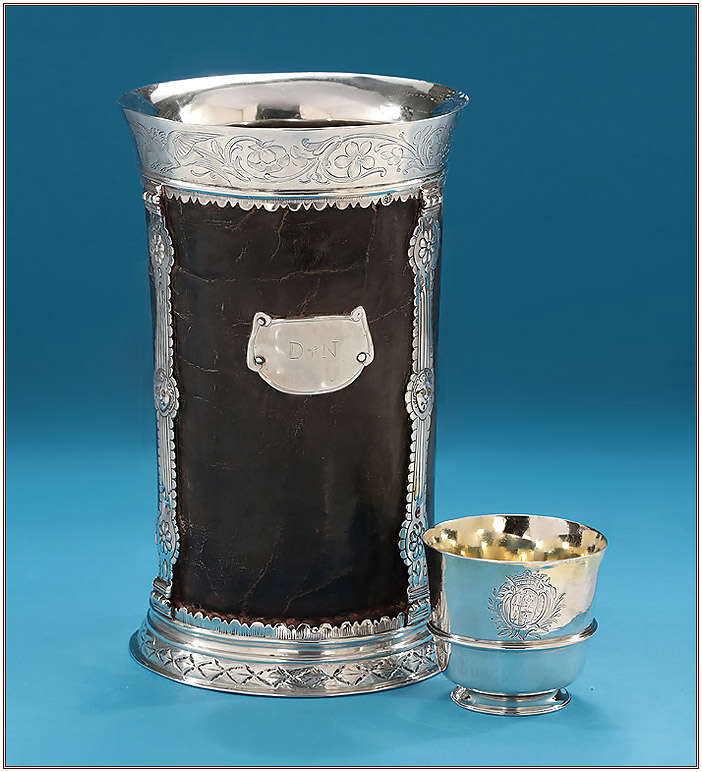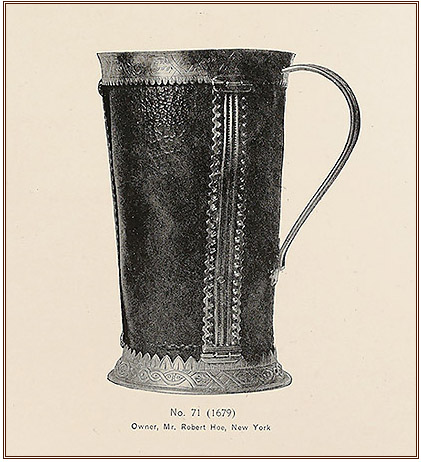M. FORD CREECH ANTIQUES & FINE ARTS
www.mfordcreech.com
"SUPER-CUP!"
THE QUINTESSENTIAL BRITISH LEATHERN
"BLACK-JACK"

SCARCE
SILVER-MOUNTED LEATHER BLACK-JACK
Maker’s Mark I.T, Within a Pelleted Oval
England, 18th Century
Of large beaker form,
the stitched tapering leather vessel having a
silver foot and rim mount :
the rim mount with
scrolling foliage and flora centering gryphons, and
above an incised scalloped edge;
the lower mount also
with a vertically incised scalloped edge
above a spreading footrim
chased with laurel diapering;
the two mounts connected by three hinged strapwork supports having scalloped edges
and chased central
mask faces between upper and lower flowerheads;
the front with a shaped silver cartouche scratch-initialed D * N
8.25” High
/ 5.25" Diameter / Volume of 44 oz.
Although the use of leather drinking vessels extends to ancient times, their use in Britain is longer -
and in greater number - than anywhere else in history.
A Neolithic beaker of
tanned cowhide (some hair still attached) was found at West Smithfield, London.
And waterproof leather bags joined by the neck, referred to as
"drinking vessels",
were introduced into England during the Crusades.
These were but forerunners of the hard bodied water bottle -
and the well loved quintessentially British leather "Black-Jack".
For those of you unfamiliar with the black-jack :
"The 'Black-Jack' was a kind of leather pitcher or jug, always lined with pitch on metal,
of massive and sturdy build, corpulent and capacious.
It quite dwarfed all rival pots, mugs, or pitchers of leather."
The leathern vessel retained its high place in both taverns and homes for many centuries.
"Every man of substance took his meals in his hall with his family and servants…. "
When the more luxurious 18th century dining fashions arrived,
"the lord took his meals privately in parlour or dining room,
and the leathern pot re-mained in the servants' hall -
with the exception of those that were silver mounted.
These latter were smaller as a rule and more richly treated;
they were edged with silver and often lined with that metal or with pewter
in the seventeenth and eighteenth centuries -
and were highly prized."
For more, please click
here
(Pictured
above with a
William & Mary Silver Tot Cup, Ralph Leake, London, 1695)

A tapered form Black-Jack (1679), Old London Silver, Montague Howard, p. 115, Pl. No. 71

Please Click To View Our 2017 New & Incoming Page
(Dec. 2016 to Present)
Please call or email if you wish additional information
901-761-1163 (gallery) / 901-827-4668 (cell)
M. FORD CREECH ANTIQUES & FINE ART
581 S. PERKINS ROAD / LAURELWOOD COLLECTION / MEMPHIS, TN 38117
Hours : Wed.-Sat. 11-6, or by appointment
Complimentary Gift Wrapping
mfcreech@bellsouth.net or mfordcreech@gmail.com
www.mfordcreech.com
To receive our periodic email catalogs, please click here
American Express, Mastercard, Visa and Discover accepted
Home Accessories Ceramics Early Asian Ceramics Fine Art Furniture Glassware Silver
 
© Some images are copyrighted by their authors and used by permission.
They appear here for your enjoyment only.
Please do not reproduce without specific written permission.
"The Quintessential British Leathern Black Jack"; M. Ford Creech Antiques
|